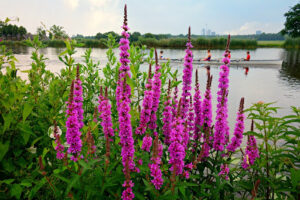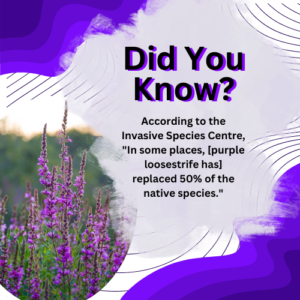Written by: Tvisha Lakhani
Edited by: Ravjyot Ughra
Designed by: Tvisha Lakhani
Published by: Maryam Khan

It’s a sunny summer mid-afternoon, and you’re driving by expanses of greenery when you pass a field of tall pinkish purple flowers. You might be captivated by their beauty, but beware: these are a notorious species of plant known as purple loosestrife.
Purple loosestrife–scientific name lythrum salicaria–is found across North America and has invaded almost every US state and Canadian province and territory. Purple loosestrife is generally between 60 to 120 cm, but it can grow up to a height of 2 meters. It has a thick, woody, square-shaped stem, and the plant blooms flowers that can range from shades of dark pink to violet.
 The origins of the purple loosestrife can be traced back to Europe and Asia. It was brought to the Atlantic coast of North America in the early 1800s for beekeeping and ornamental purposes. It is also believed to be unintentionally brought through the soil in the ballasts of ships at that time. By the end of the 19th century, purple loosestrife was widespread across the United States and Canada.
The origins of the purple loosestrife can be traced back to Europe and Asia. It was brought to the Atlantic coast of North America in the early 1800s for beekeeping and ornamental purposes. It is also believed to be unintentionally brought through the soil in the ballasts of ships at that time. By the end of the 19th century, purple loosestrife was widespread across the United States and Canada.
Currently in Ontario, the plant is found throughout the Great Lakes-St. Lawrence River Basin. It prefers wetlands and sun, although it can endure up to 50% shade. This plant is extremely adaptable; it can survive in almost any type of soil.
Purple loosestrife is harmful to the ecosystem for several reasons. The growth of purple loosestrife plants can change the nutrient cycle of the area. This in turn can affect other species, leading to a chain reaction. Purple loosestrife has a negative impact on the overall biodiversity of the ecosystem. It crowds out native plants and competes with them for resources like nutrients in the soil and water. Large amounts of purple loosestrife growth can block irrigation canals and deteriorate the quality of land for agricultural purposes.
To face the growing invasion of purple loosestrife, the Canadian government released two beetles into areas with high purple loosestrife growth in 1992. These two beetles were natural enemies of the purple loosestrife and fed off of the plant. In the areas where these beetles were released, the population of purple loosestrife decreased by up to 90%. As of now, there are many provinces in Canada that have regulations in place to control the population of purple loosestrife, including British Columbia, Alberta, Manitoba, Prince Edward Island, and Saskatchewan.
If you see purple loosestrife on your property, the ideal time of the year to remove it is when it is in bloom, from early to mid summer, although early August works too. To report a sighting of purple loosestrife or any other invasive species, please contact the Invading Species Hotline at 1-800-563-7711.
Works Cited
Invasive Species Centre. (n.d.). Purple Loosestrife. https://www.invasivespeciescentre.ca/invasive-species/meet-the-species/invasive-plants/purple-loosestrife/
Invasive Species Council of British Columbia. (2017, March). Purple Loosestrife. https://bcinvasives.ca/wp-content/uploads/2021/01/Purple_Loosestrife_TIPS_2017_WEB.pdf
Midwest Invasive Species Information Network & Michigan Natural Features Inventory. (n.d.). Purple loosestrife (Lythrum salicaria). Midwest Invasive Species Information Network. https://www.misin.msu.edu/facts/detail/?id=32
Minnesota Department of Natural Resources. (n.d.). Purple loosestrife (Lythrum salicaria). https://www.dnr.state.mn.us/invasives/aquaticplants/purpleloosestrife/index.html
Ontario Invasive Plant Council. (2016, April). Purple Loosestrife (Lythrum salicaria) – Best Management Practices in Ontario. http://www.ontarioinvasiveplants.ca/wp-content/uploads/2016/07/Purple-Loosestrife-BMP-April-2016-final.pdf
Ontario’s Invading Species Awareness Program. (2021). Purple Loosestrife. https://www.invadingspecies.com/invaders/plants/purple-loosestrife-2/
Kunkle, S. (2020). Purple flowers in tilt shift lens photo [Photograph]. Unsplash. https://unsplash.com/photos/F27Be0irRUs
Amber, M. (2016). Purple Loosestrife Lythrum Flower [Photograph]. Pixabay. https://pixabay.com/photos/purple-loosestrife-lythrum-flower-1485894/

